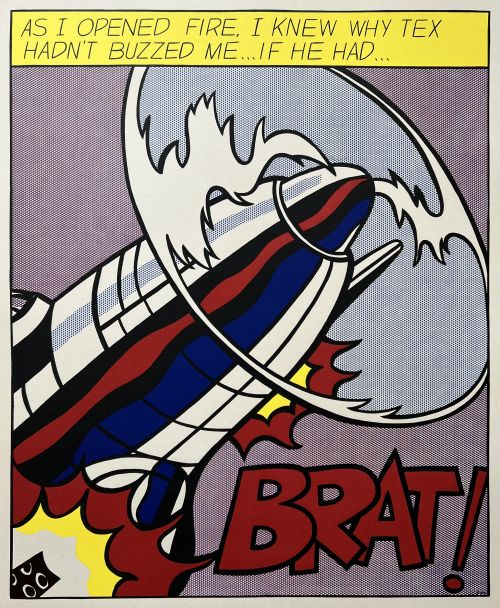About the artist:
American artist, one of the leading figures of American "Pop Art".
Roy Lichtenstein first became interested in art and design as a hobby.
Artist began taking painting classes at the Art Students League of New-York and later he enrolled at Ohio
State University, where he studied drawing and design along with botany, history, and literature.
In 1946, Lichtenstein received his bachelor of fine arts degree from Ohio State University and stayed there for a
teaching position for the next ten years.
In 1948, Lichtenstein first exhibited his works at the Ten-Thirty Gallery in Cleveland. At that time, his works did not
differ in originality and novelty, which did not impress critics and connoisseurs of the genre.
Despite the relative lack of interest in his work in Cleveland, Lichtenstein did place his work with New York
dealers, which always mattered immensely to him. He had his first solo show at the Carlebach Gallery in New
York in 1951. Then the critics noticed the works of the master, focusing on unique tones and non-standard
subjects.
In the 1950s, Lichtenstein changed his style dramatically, being more interested in advertising posters, comics
and images associated with mass culture.
In 1956 he created the first work - a forerunner of the style "pop art" - a lithography "10 dollars".
In the late 1950's, he artist began to work actively in the style of abstract expressionism.
Since 1961, Lichtenstein's works has begun to change Under the influence by the work of colleague Allan
Kaprow, he turned to the use of comic-strip and cartoon figures by which he is known today.
Roy Lichtenstein's technique consisted in a kind of processing of the liked images taken from magazines and
cartoons. He enlarged the images by manually redrawing the raster and printed them in silkscreen technique.
His works were more similar to a seal, not a drawing, because Lichtenstein used several basic typographic colors
(red, blue, yellow), a black line and points, with which he created the depth and volume of the image.
Lichtenstein said: "These pictures should look like a fake, and I think I succeed. I think I'm not just repainting
comics, but I'm bringing something new and, as a result, I'm creating a work of art." Artist sought to reflect the
ironic and sarcastic features of his characters in his works.
In the 1960s, Roy Lichtenstein was on the top of success. His paintings were acquired by the most famous and
prestigious galleries. The famous art dealer Leo Castelli represented Lichtenstein, and the first exhibition of the
comic-book paintings held at his gallery in 1962. This exhibition had a great commercial success, and his
innovative work found an international audience.
Since 1964 Lichtenstein’s works had begun to include still lifes and landscapes, and they were a dramatic
departure from his earlier style in their use of brushstrokes as well as in their subject matter.
In 1965, the Stedelijk Museum bought the artist's painting "As I Opened Fire" for its permanent collection. This
painting was created based on comic books.
The first major retrospective exhibition by Lichtenstein was held in Tate Modern in 1968.
The 1970s saw Lichtenstein continuing to experiment with new styles. He was actively engaged in sculpture and
printmaking (the series of "Bull" and "Artist's Studio"), began to use the decorative motifs of the art by the
American Indians and created his own versions of famous classical paintings ("Still Life with Golden Fishes" by
Henri Matisse).
In the 1990s, Lichtenstein created the series of genre paintings of Late Nudes reprised the theme of women in a
romance-comic mode, which Lichtenstein had introduced in the 1960s. In this series his classic reception of
"point" gave a way to broad and vivid strokes in the spirit of abstract expressionism.
Artist was awarded a number of honorable awards in the field of art for his creative works.
He was a member of the American Academy of Arts and Sciences, a doctor of fine arts at the Southampton
College in New York, a doctor of arts at the University of Ohio.
In 1996, Lichtenstein was awarded the title of Honorary Doctor of Fine Arts of the George Washington University.
The artist's works are represented in the most famous museums of the world.



